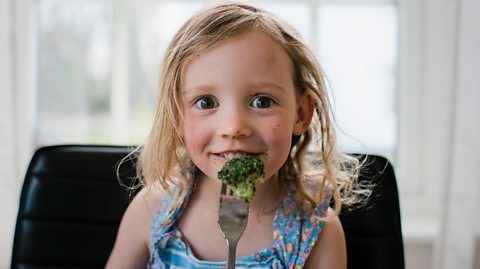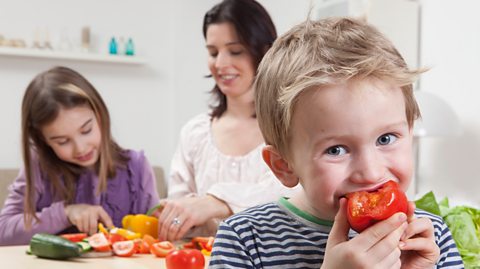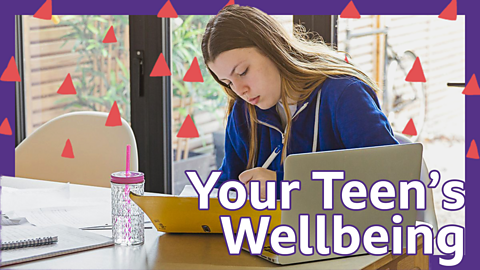The NHS says ÔÇÿchildren whose parents encourage them to be active and eat well are more likely to stay a healthy weight and grow up healthy.ÔÇÖ Studies like this have also shown that primary-aged children who eat a healthy breakfast do well at school.
ItÔÇÖs can be hard enough getting something healthy into our own bellies, so how do we make it easy and affordable to do the same with our kids, whatever their age? Often half the battle is helping our kids understand why eating a range of healthy foods - and not as many sweets and snacks - is important.
Here to help is Priya Tew - a dietitian who features on ┤¾¤¾┤½├¢1ÔÇÖs Eat Well for Less. With three children of her own, sheÔÇÖs learned a few hacks for helping her kids to understand food and eat more healthily all year round.

1. Let them help themselves

Priya says: ÔÇ£I believe children are born with an innate sense of knowing what is good for them.ÔÇØ We can capitalise on that - by offering a range of healthy foods, but letting the children make some decisions for themselves.
There are four main food groups our children need each day: starchy carbohydrates, fruit and vegetables, dairy (or appropriate substitutes) and protein. Priya advises
Offer a range of foods
ÔÇ£Put a range of balanced, nutritious foods on the table. ItÔÇÖs important to offer a variety of food - donÔÇÖt get stuck in the rut of only eating the same veg!
Let them plate up
ÔÇ£Have the food out on the table so the children can help themselves, or ask them where they want it on their plate before you dish it up. They can then set their plate out in the way they want.
Offer food in different ways
ÔÇ£Try cutting it differently into shapes or cooked in a different way. For example, some of my children will eat courgettes if they are roasted in breadcrumbs, but not just in a stir fry.ÔÇØ You can also try making their plate look extra colourful, with a wide variety of fruit and veg.
Be a good role model
ÔÇ£Demonstrate healthy eating yourself. Sit down and eat with the children, showing them you enjoy a variety of different foods - fruit and veg, grains and proteins.ÔÇØ
Priya adds: ÔÇ£Try not to put too much pressure on the child. Even if they donÔÇÖt eat what is put out, youÔÇÖre showing them different types of vegetables. It can take a long time for them to try something, so even one mouthful is a success. Give little bits of encouragement along the way.ÔÇØ

2. Get them involved

Priya says: ÔÇ£Get them cooking and preparing food as soon as you can. You are more likely to eat something when youÔÇÖve helped make it.ÔÇØ
Here are some ways you can do that
Meal planning
ÔÇ£It sounds complicated, but just ask the child what kind of meal they want to eat this week. My youngest will say the same answer every time - ÔÇÿpastaÔÇÖ. Then IÔÇÖll be more specific: ÔÇÿWhat vegetable do you want to go with it? What new things can we try?ÔÇÖ
Choosing recipes
ÔÇ£I can give my ten-year-old a recipe book or stick her on a pre-vetted website and say: ÔÇÿDo you think you can find a new recipe that we can try this week?ÔÇÖ I will find the websites I feel comfortable and safe with, and I will be cooking as sheÔÇÖs doing it, so IÔÇÖm close at hand.
Setting aside a particular time
ÔÇ£You donÔÇÖt need to be actively cooking with your child every day. Find a day in the week or at the weekend. I have three children, so I have one day per child. Life gets busy - so you could just do some baking at the weekend.
Laying the table
ÔÇ£I have one child who likes to set the table. Even laying the table and making the table environment feel welcoming helps involve the kids.ÔÇØ

3. Let them shop with you

After youÔÇÖve made a meal plan, the next stage is buying the ingredients. Many children love shopping and choosing things - and itÔÇÖs a great way to sneak in some education too.
Shop local
Priya says: ÔÇ£I like going to the local fruit and veg shop, going around talking about the different veg. I let them choose something different they want to try. It doesnÔÇÖt matter if they donÔÇÖt like it, itÔÇÖs about being safe to experiment and try different things.
Go frozen
ÔÇ£Frozen can be just as nutritious as fresh versions, so get in a range of frozen veg. That can be really useful as it also saves waste - you can just grab a few handfuls from the freezer.
Use everything
ÔÇ£Make use of the freezer. If you have leftover veg - roast them and put them in tupperware, then use them with pasta or as a side dish another time.
Shop together online
"If youÔÇÖve already got a recipe in mind, you can sit with your child and choose the foods you need online. Younger children enjoy pressing the buttons and can learn the names of different fruit and veg, whilst older children will feel like theyÔÇÖre in control!"
Priya adds: ÔÇ£Think about the mealtime environment too. Try not to make it stressful, so the child can see it as just getting together and having a chat.ÔÇØ

4. Help them learn about nutrition

Children will be learning about nutrition in school. In Key Stage 2 in England and Wales (ages 7 to 11) children will learn about different food groups and eating a balanced diet.
At secondary school, children will learn about preparing and cooking food, as well as the nutrients our bodies need to keep us healthy. You can help support their learning with positive conversations around things like eating enough fruit and veg.
Keep it fun
Priya says: ÔÇ£ItÔÇÖs about coming up with little messages about things. I might say ÔÇÿcarrots are good for your eyesightÔÇÖ, or ÔÇÿPopeye used to eat spinach for big musclesÔÇÖ. Make it positive, fun and amusing, so it will stick in their heads.
Tailor your message
ÔÇ£IÔÇÖve got a child whoÔÇÖs into super heroes, so I will talk about the Green Giant on a sweetcorn tin. Or IÔÇÖll use rhymes, like this one: ÔÇÿI eat my peas with honey; I've done it all my life. It makes the peas taste funny, But it keeps them on the knife!ÔÇÖ
Think seasonal
ÔÇ£Teach them about the seasons - that different things come up at different times of the year. ItÔÇÖs also about knowing how long it takes for things to grow, and that itÔÇÖs not that simple - thereÔÇÖs quite a lot of work in it.
Pick or grow your own
ÔÇ£Children love going to pick things, or even better is to grow your own and let them pick them. It doesnÔÇÖt have to be complicated - you can try tomato plants and runner beans in pots on a balcony. You donÔÇÖt need a massive garden to do anything.
Eat the rainbow
ÔÇ£Talk about eating a rainbow. For example: ÔÇÿYou canÔÇÖt just eat carrots because they are orange, our bodies need green and red and yellow and purpleÔǪ' This means making sure you have a large variety of fruit and vegetables in your diet, with lots of different colours on your plate each day."
┤¾¤¾┤½├¢ Food have some great eat the rainbow ideas on their site.

5. Help them to understand their own bodies

As adults, if we listen to our bodies, most of us know when weÔÇÖre hungry and when weÔÇÖre full. But sometimes we can take that choice away from our children without really meaning to - for example, by making them finish everything on their plate when theyÔÇÖre already full.
Help them tune in
ÔÇ£Get them to listen to their fullness and hunger. Ask them, ÔÇÿWhat does it feel like?ÔÇÖ ItÔÇÖs important we keep them listening to their hunger and fullness cues.
Gently reset their bodies
ÔÇ£Some children can get used to large portions of sweets, so sometimes we need a chat and a reset. Say things like, ÔÇÿToo many sweet things are not good for our bodiesÔÇÖ. Teach them long term how to regulate their own appetite.
ItÔÇÖs okay to have some treats
ÔÇ£ItÔÇÖs about balancing their snacks, and saying, ÔÇÿSweets wonÔÇÖt keep you full up, it tastes delicious, but you need something substantial alongside it. LetÔÇÖs put carrots and hummus, or apple and peanut butter with it. So, youÔÇÖve got protein with fruit and veg, to help keep you full.ÔÇÖ

Understand your childÔÇÖs individual needs too
ÔÇ£I have one child who always wants an apple after school, and another who needs something like a piece of toast, otherwise heÔÇÖs really hungry. He needs something like toast and peanut butter.ÔÇØ
Ultimately, this is about arming your kids with the tools they need to make healthy choices and thrive. ItÔÇÖs not necessarily an easy journey, but it is one you can enjoy together.
Priya concludes: ÔÇ£Some parents can get understandably quite disheartened - youÔÇÖve spent time and hard effort and your kids are not eating a range of foods. But donÔÇÖt give up, keep trying."
ÔÇ£Parenting is hard - we donÔÇÖt always get it right. When teaching kids about food and nutrition, itÔÇÖs just doing your best and staying as positive and full of encouragement as you can.ÔÇØ


For further food fun that will engage you and your children, try these links
Here are some healthy recipes for kids from ┤¾¤¾┤½├¢ Food that you can try at home.
Or try this link for some healthy recipes that your kids can help cook

More from ┤¾¤¾┤½├¢ Bitesize Parents' ToolkitÔǪ
Parents' Toolkit
Fun activities, real-life stories, wellbeing support and loads of helpful advice - we're here for you and your child.

How to tackle anxiety with Dr Anna
Calming techniques to help parents and children manage their anxiety.

How to help your child embrace boredom
You don't need to be worried if your kids are bored in lockdown - Dr Sandi Mann offers some reasons why.

How to transform a smaller space for study or work
Many of us are having to make do with the little spaces in our homes for work or study. Here's how to make them feel bigger!


